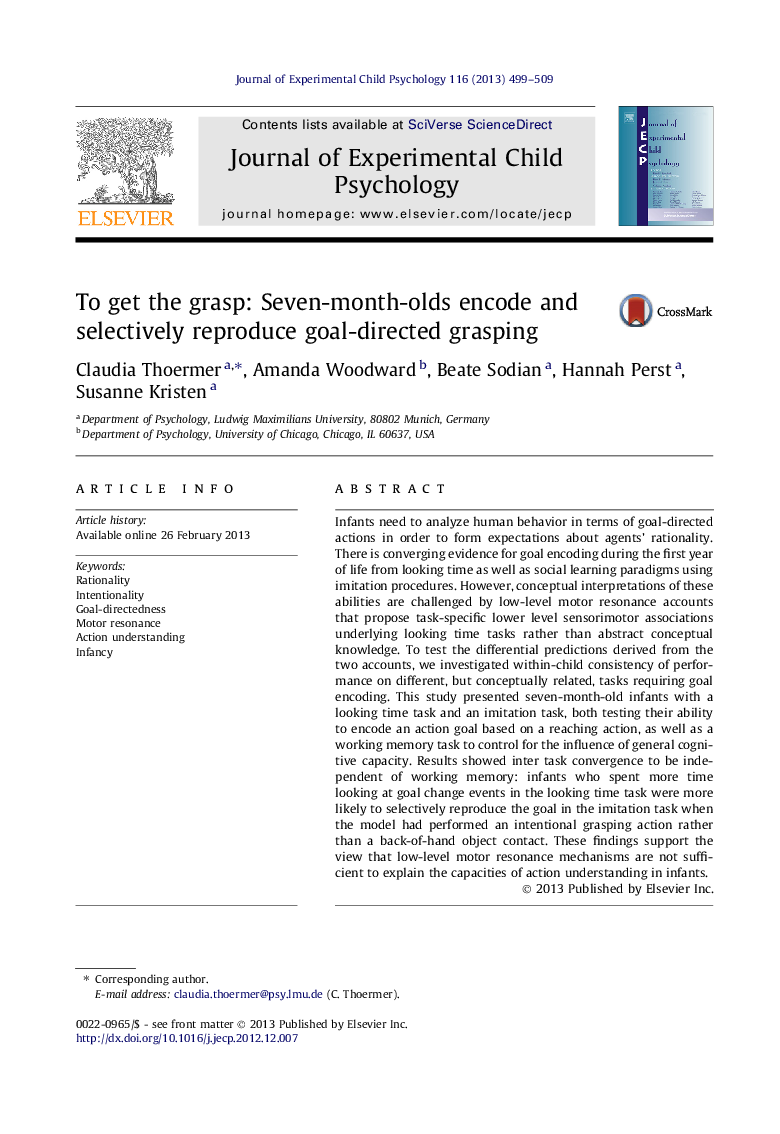| کد مقاله | کد نشریه | سال انتشار | مقاله انگلیسی | نسخه تمام متن |
|---|---|---|---|---|
| 10453100 | 919457 | 2013 | 11 صفحه PDF | دانلود رایگان |
عنوان انگلیسی مقاله ISI
To get the grasp: Seven-month-olds encode and selectively reproduce goal-directed grasping
ترجمه فارسی عنوان
برای رسیدن به درک: هفت ماهه ها کدگذاری و گزینش هدفمند به دست می دهند
دانلود مقاله + سفارش ترجمه
دانلود مقاله ISI انگلیسی
رایگان برای ایرانیان
کلمات کلیدی
عقلانیت، اندیشه هدایت هدف، تشدید حرکت موتور، درک عملی نوزادان،
ترجمه چکیده
نوزادان نیاز به تجزیه و تحلیل رفتار انسانی را از لحاظ اقدامات هدفمند جهت تجزیه و تحلیل انتظارات در مورد عقلانیت عاملان دارند. شواهد همگانی برای رمزگذاری هدف در طول اولین سال زندگی از زمان جستجو و همچنین پارادایم های یادگیری اجتماعی با استفاده از روش های تقلبی وجود دارد. با این حال، تفسیرهای مفهومی از این توانایی ها توسط حساب های تشدید حرکتی پایین در معرض خطر قرار می گیرند که پیشنهادات مرتبط با سنسورهای حرکتی پایین تر را به دلایل وظایف زمان جستجو نسبت به دانش مفهومی انتزاعی پیشنهاد می کنند. برای تست پیش بینی های دیفرانسیسی که از دو حساب گرفته شده است، ما در مورد سازگاری درونی فرزندان در کارهای مختلف، اما مفهومی مرتبط، که نیازمند کدگذاری هدف است، مورد بررسی قرار گرفتیم. این مطالعه نوزادان هفت ماهه را با وظیفه زمانی به دنبال و یک کار تقلیدی ارائه داد، هر دو توانایی خود را برای رمزگذاری یک هدف عملی بر اساس یک اقدام رسمی و همچنین یک کار حافظه کاری برای کنترل نفوذ ظرفیت شناختی عمومی . نتایج نشان داد که همگرایی وظیفه ای مستقل از حافظه کاری است: نوزادانی که بیشتر وقت خود را به دنبال رویدادهای تغییر اهداف در وظیفه زمان جستجو می کردند، احتمال بیشتری برای انتخاب هدف در کار تقلید را در مقایسه با مدل انجام دادند یک مخاطب پشتی دست. این یافته ها این دیدگاه را تأیید می کند که مکانیسم های رزونانس حرکتی کم در اندازه گیری توانایی درک درک در نوزادان کافی نیست.
موضوعات مرتبط
علوم انسانی و اجتماعی
روانشناسی
روانشناسی رشد و آموزشی
چکیده انگلیسی
Infants need to analyze human behavior in terms of goal-directed actions in order to form expectations about agents' rationality. There is converging evidence for goal encoding during the first year of life from looking time as well as social learning paradigms using imitation procedures. However, conceptual interpretations of these abilities are challenged by low-level motor resonance accounts that propose task-specific lower level sensorimotor associations underlying looking time tasks rather than abstract conceptual knowledge. To test the differential predictions derived from the two accounts, we investigated within-child consistency of performance on different, but conceptually related, tasks requiring goal encoding. This study presented seven-month-old infants with a looking time task and an imitation task, both testing their ability to encode an action goal based on a reaching action, as well as a working memory task to control for the influence of general cognitive capacity. Results showed inter task convergence to be independent of working memory: infants who spent more time looking at goal change events in the looking time task were more likely to selectively reproduce the goal in the imitation task when the model had performed an intentional grasping action rather than a back-of-hand object contact. These findings support the view that low-level motor resonance mechanisms are not sufficient to explain the capacities of action understanding in infants.
ناشر
Database: Elsevier - ScienceDirect (ساینس دایرکت)
Journal: Journal of Experimental Child Psychology - Volume 116, Issue 2, October 2013, Pages 499-509
Journal: Journal of Experimental Child Psychology - Volume 116, Issue 2, October 2013, Pages 499-509
نویسندگان
Claudia Thoermer, Amanda Woodward, Beate Sodian, Hannah Perst, Susanne Kristen,
